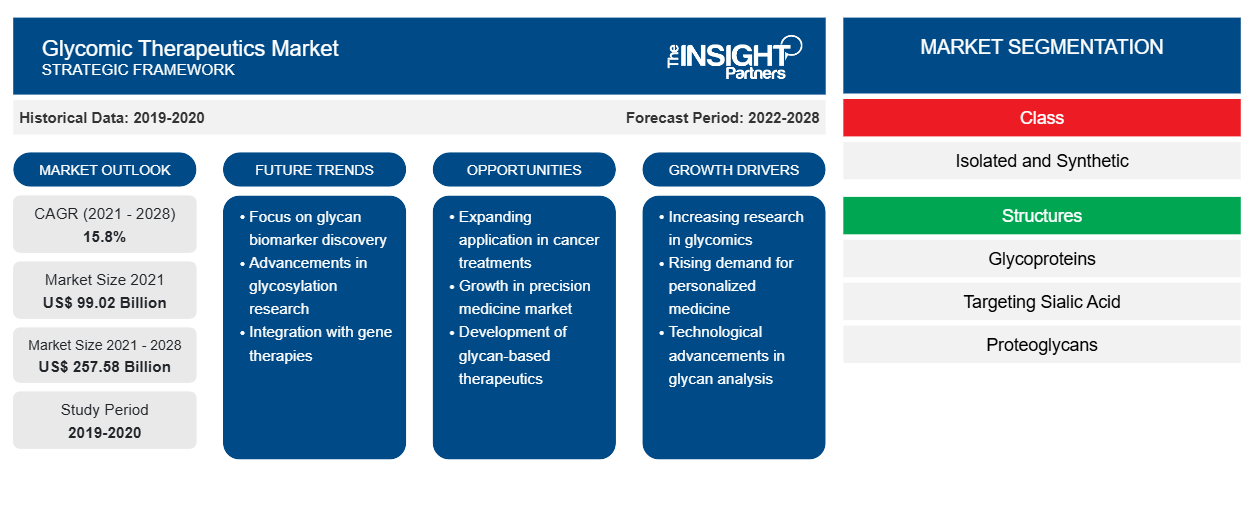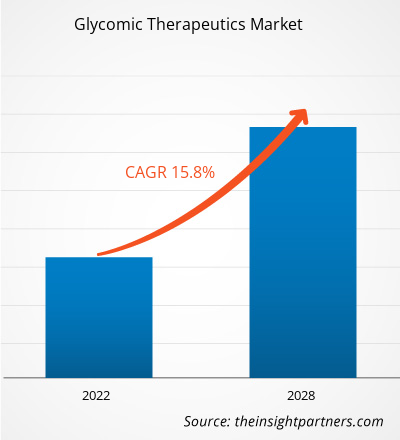The glycomic therapeutics market is expected to grow from US$ 99,021.46 million in 2021 to US$ 257,578.79 million in 2028; it is estimated to grow with a CAGR of 15.8% from 2022 to 2028.
The report highlights prevailing trends and factors driving the market growth. Glycomics focuses on the structures and functions of complex carbohydrates, as found in glycoproteins, glycolipids, and glycosaminoglycans. Glycans are responsible for much of the structural variation in biological systems, and their representation on cell surfaces is commonly called the “glycome”. These glycans are present in many areas of the microbiome, including cell surfaces and proteins, and can be incredibly complex. Microbial glycomics is poised to revolutionize disease diagnosis, cancer detection, personalized medicine, antimicrobial vaccine, and drug discovery. As therapeutic agents, glycan-integrated nanomaterials can be used as a vaccine against viral and bacterial infections and cancer cells.
The report offers insights and in-depth analysis of the global glycomic therapeutics market, emphasizing various parameters, including market trends, technological advancements, market dynamics, and competitive landscape analysis of global leading market players. It also includes the impact of the COVID-19 pandemic on the market across all regions. The overall impact of the COVID-19 pandemic on the glycomic therapeutics market was mixed; hence, the market is still gaining traction and is expected to grow in the coming years. The health care systems were overburdened, and the delivery of medical care to all patients became a challenge. In addition, the biotechnology industry faced the undesirable impact of the pandemic. During the COVID-19 pandemic, medical device companies found difficulties managing their operations. Many companies of glycomic therapeutics had their business operations in the US, and the pandemic severely affected several businesses. However, after the pandemic restrictions normalized, the volume of surgical procedures returned to normal levels. Gradually hospitals resumed elective procedures as the COVID-19 recovery rate was increasing. The demand for glycan-based drugs in medical therapeutics and vaccine development applications has also increased.
Customize This Report To Suit Your Requirement
You will get customization on any report - free of charge - including parts of this report, or country-level analysis, Excel Data pack, as well as avail great offers and discounts for start-ups & universities
Glycomic Therapeutics Market: Strategic Insights

-
Get Top Key Market Trends of this report.This FREE sample will include data analysis, ranging from market trends to estimates and forecasts.
Geography-Based Insights
By geography, the global glycomic therapeutics market is segmented into North America (the US, Canada, and Mexico), Europe (the UK, Germany, France, Italy, Spain, and the Rest of Europe), Asia Pacific (China, Japan, India, Australia, South Korea, and the Rest of Asia Pacific), the Middle East & Africa (the UAE, Saudi Arabia, South Africa, and the Rest of Middle East & Africa), and South & Central America (Brazil, Argentina, and the Rest of South & Central America).
Market Insights
Increasing Research and Development in the Field of Glycomic Therapeutics
Glycans are exceedingly complex and found in many areas of the microbiome components, such as proteins and cell surfaces. Researchers and players are actively involved in the glycomics industry and are constantly focusing on technological developments to offer better alternatives to conventional techniques. A few examples of research & development in the glycomic therapeutics market are mentioned below:
- In February 2022, the National Science Foundation (NSF) awarded ~US$ 23 million to a new multi-university partnership, jointly led by Virginia Tech and the University of Georgia, 2020, to accelerate glycomaterials research in the US. This partnership brought together top scientists and engineers from these institutions, along with Brandeis University, Rensselaer Polytechnic Institute, and the University of North Carolina at Chapel Hill, to establish a national glycomaterials research center.
- In March 2022, Palleon Pharmaceuticals, a company pioneering the field of glycol-immunology to treat cancer and inflammatory diseases, announced the dosing of the first patient in the company’s Phase 1/2 study of E-602 in patients suffering from advanced cancers. The study, called GLIMMER-01 (Glycan-Immune Regulation), is the first clinical study of Palleon’s novel approach to cancer immunotherapy, which targets immunosuppressive sialoglycans.
- In April 2022, CPTAC glycoproteomic researchers developed "Peptide-First" multi-attribute glycan identification method.
- In March 2022, Japanese researchers uncovered the precise mechanism of a beta-1,2-glucan-associated enzyme to provide new information on complicated sugar metabolism. A team of researchers from Niigata University and Tokyo University of Science identified the structure and function of a new enzyme with glycosyltransferase activity. The findings of this investigation were made public on January 19, 2022, and were printed in the Journal of Biological Chemistry, Volume 298, Issue 3.
- According to a study published in February 2022 by researchers at the University of Copenhagen's Center for Glycomics, Heparin can now be produced without using animals through glycomics studies.
- In February 2022, GlycoMIP, a national research hub focused on glycomaterials research and led jointly by Virginia Tech and the University of Georgia, celebrated the grand opening of its national user facility with ribbon-cutting ceremonies at both universities. GlycoMIP will address nationwide bottlenecks in glycomaterial synthesis, computer modeling, material characterization, and knowledge sharing through ground-breaking research and a unique national user facility that will provide critical tools and services to the scientific community.
Such advancements in the field of glycomics propel the glycomic therapeutics market growth significantly.
Class-Based Insights
Based on the class, the glycomic therapeutics market is bifurcated into isolated and synthetic. In 2021, the synthetic segment accounted for a larger market share. However, the isolated segment is expected to register a higher CAGR of 16.3% during the forecast period.
Structure-Based Insights
Based on structures, the glycomic therapeutics market is segmented into glycoproteins, targeting sialic acid, proteoglycans, targeting glycosaminoglcans, glycophosphatidylinositol (GPI)-anchored proteins & heparin based glycans, targeting glycosphingolipids, and others. The glycoproteins segment held the largest market share in 2021. However, the targeting sialic acid segment is anticipated to register the highest CAGR during the forecast period.
Indication-Based Insights
Based on indication, the glycomic therapeutics market is segmented into thrombosis & chemoprophylaxis, anemia, anti-adhesive & anti-inflammatory, cataract, Gaucher’s diseases, MPS-1 & IV, cancer, Alzheimer’s disease, influenza type A & B, and others. The influenza type A & B segment held the largest market share in 2021, and it is expected to continue a similar trend during the forecast period.
Glycomic Therapeutics Market Regional InsightsThe regional trends and factors influencing the Glycomic Therapeutics Market throughout the forecast period have been thoroughly explained by the analysts at The Insight Partners. This section also discusses Glycomic Therapeutics Market segments and geography across North America, Europe, Asia Pacific, Middle East and Africa, and South and Central America.
Glycomic Therapeutics Market Report Scope
| Report Attribute | Details |
|---|---|
| Market size in 2021 | US$ 99.02 Billion |
| Market Size by 2028 | US$ 257.58 Billion |
| Global CAGR (2021 - 2028) | 15.8% |
| Historical Data | 2019-2020 |
| Forecast period | 2022-2028 |
| Segments Covered |
By Class
|
| Regions and Countries Covered |
North America
|
| Market leaders and key company profiles |
|
Glycomic Therapeutics Market Players Density: Understanding Its Impact on Business Dynamics
The Glycomic Therapeutics Market is growing rapidly, driven by increasing end-user demand due to factors such as evolving consumer preferences, technological advancements, and greater awareness of the product's benefits. As demand rises, businesses are expanding their offerings, innovating to meet consumer needs, and capitalizing on emerging trends, which further fuels market growth.

- Get the Glycomic Therapeutics Market top key players overview
Mode of Action-Based Insights
Based on mode of action, the glycomic therapeutics market is segmented into inhibits neuraminidase; inhibits heparanase and selectins and blocks interactions between growth factors and heparan sulfate; erythropoietin & enzyme replacement therapy (ERT); tissue plasminogen activator; inhibits glucosylceramide synthase; interleukin 1, 2 & 3; beta & gamma interferons; and others. In 2021, the erythropoietin & enzyme replacement therapy (ERT) segment held the largest share of the market. However, the inhibits neuraminidase segment is expected to register the highest CAGR during the forecast period.
Intellihep Ltd; Protalix Biotherapeutics; BioMarin Pharmaceutical Inc.; Genzyme Corporation (Sanofi); Halozyme Therapeutics, Inc.; Bayer AG; Alzheon, Inc.; GlycoMar; GlaxoSmithKline plc.; and F. Hoffmann-La Roche Ltd are among the leading players operating in the glycomic therapeutics market. These companies have been implementing various strategies that have helped their growth, resulting in several developments in the market.
Frequently Asked Questions
What are the drivers and opportunities for the glycomic therapeutics market?
Which region is fastest growing?
Which segment led the glycomic therapeutics market?
Who are the key players in the glycomic therapeutics market?
- Historical Analysis (2 Years), Base Year, Forecast (7 Years) with CAGR
- PEST and SWOT Analysis
- Market Size Value / Volume - Global, Regional, Country
- Industry and Competitive Landscape
- Excel Dataset
Recent Reports
Testimonials
Reason to Buy
- Informed Decision-Making
- Understanding Market Dynamics
- Competitive Analysis
- Identifying Emerging Markets
- Customer Insights
- Market Forecasts
- Risk Mitigation
- Boosting Operational Efficiency
- Strategic Planning
- Investment Justification
- Tracking Industry Innovations
- Aligning with Regulatory Trends





















 Get Free Sample For
Get Free Sample For